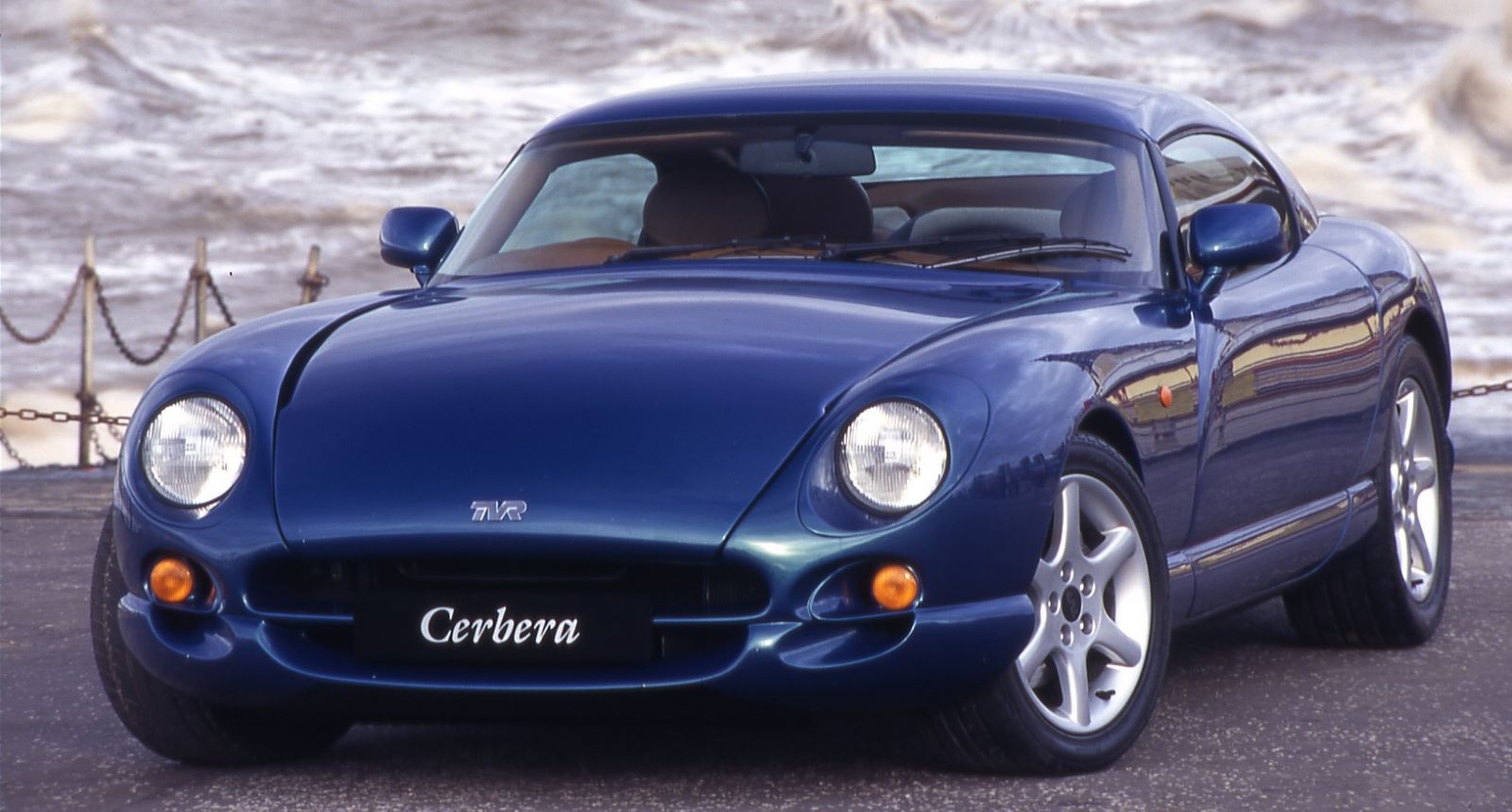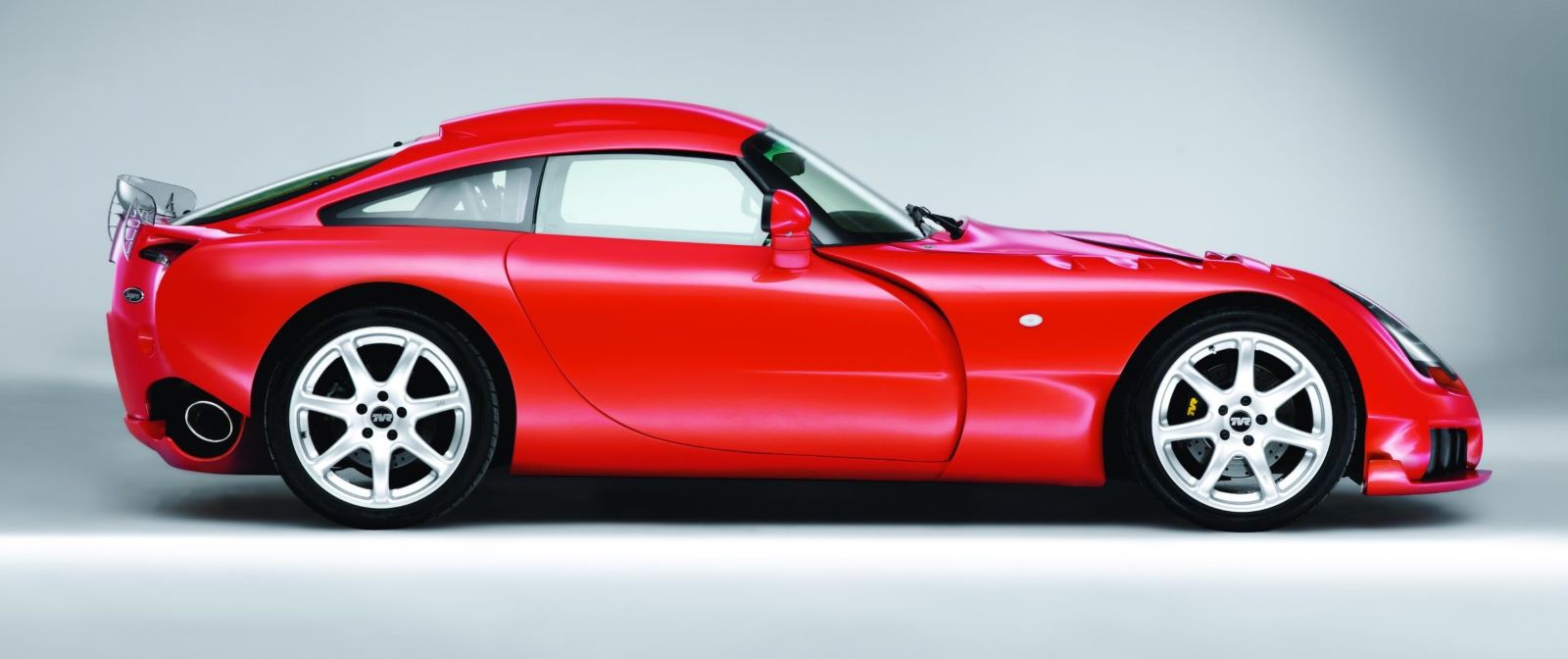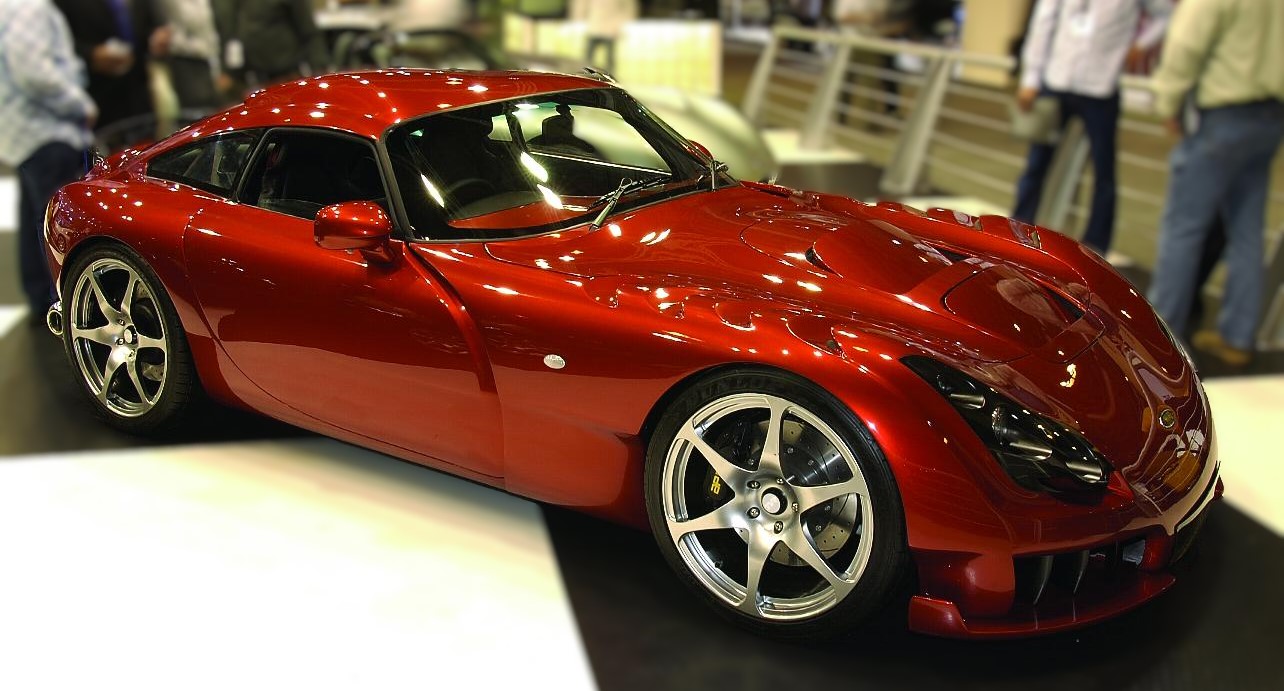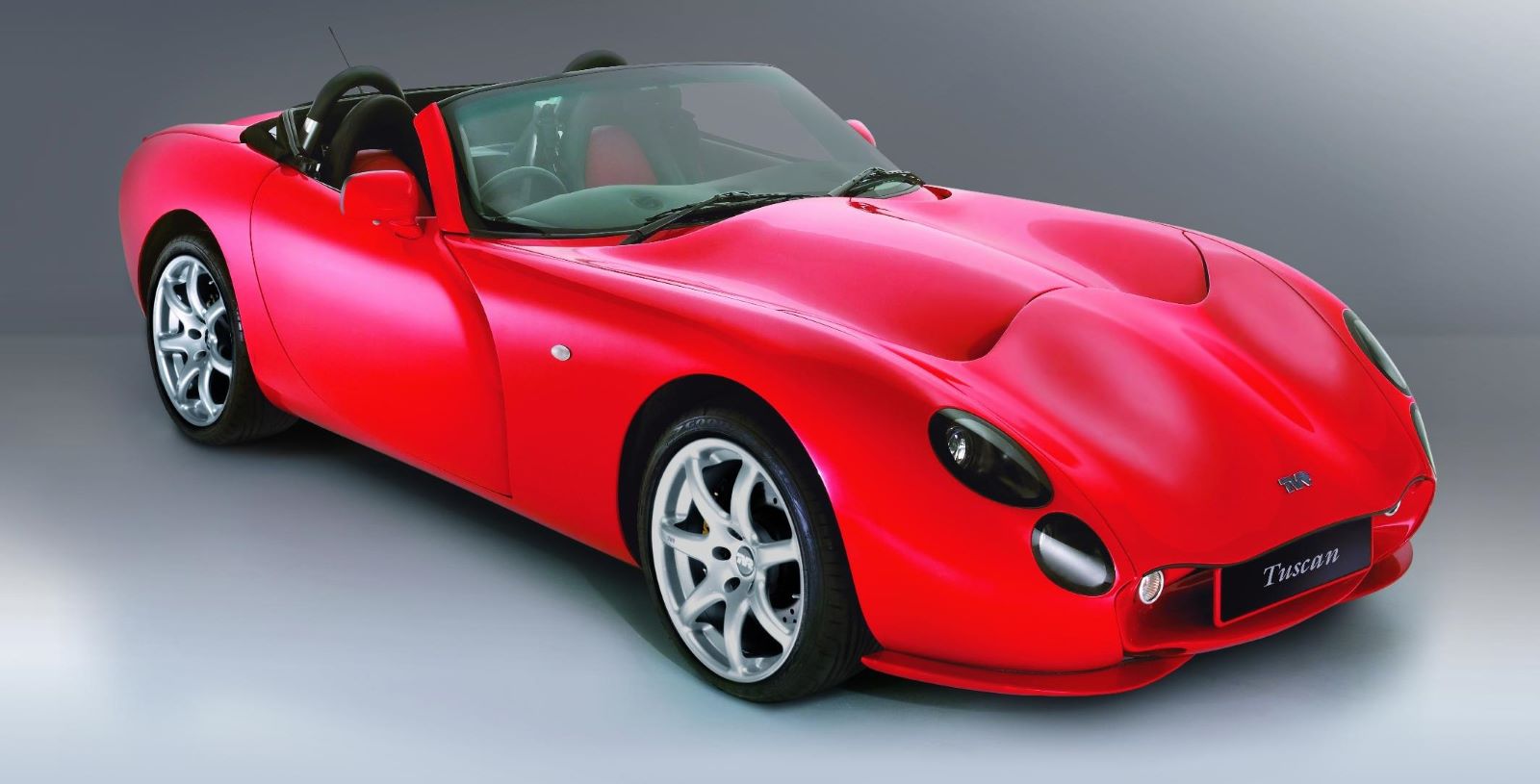
The TVR Cerbera is a high-performance sports car produced by TVR from 1996 to 2003. It was the first model from TVR to feature a V8 engine developed in-house, marking a significant milestone for the company. The Cerbera is known for its combination of brutal power, lightweight construction, and aggressive styling, making it one of TVR’s most memorable models.
Key Features of the TVR Cerbera:
- Engine Options:
- TVR AJP8 V8: The most notable engine in the Cerbera lineup is the AJP8, a 4.2- or 4.5-liter V8 engine designed and built by TVR. The 4.5-liter version produces around 420 horsepower, providing immense performance in a lightweight package. This engine is known for its raw, unfiltered power delivery and distinctive sound.
- TVR Speed Six: Later versions of the Cerbera were also available with TVR’s 4.0-liter Speed Six engine, a naturally aspirated inline-six that produces around 350 horsepower. This engine offered a slightly different character, with a focus on high-revving performance.
- Performance:
- The TVR Cerbera is exceptionally fast, with 0-60 mph times ranging from around 3.9 to 4.2 seconds, depending on the engine and configuration. The top speed is over 180 mph, making it one of the fastest cars of its time.
- Design:
- The Cerbera has a distinctive and aggressive design, characterized by its long hood, short rear deck, and wide stance. The car’s low-slung profile, prominent wheel arches, and bold front grille give it a menacing appearance. The Cerbera is a 2+2 coupe, meaning it has small rear seats, making it more practical than some of TVR’s other models.
- Chassis and Handling:
- The Cerbera features a tubular steel chassis and a lightweight composite body, consistent with TVR’s focus on reducing weight for better performance. The car’s handling is sharp and responsive, with a suspension setup designed for both road and track use.
- Interior:
- Inside, the Cerbera offers a driver-focused cockpit with a unique dashboard design. The interior features high-quality materials like leather, aluminum, and wood, giving it a bespoke, luxurious feel. The car’s gauges are often mounted in the center, with a minimalist approach to controls and switches.
- No Electronic Aids:
- True to TVR’s philosophy, the Cerbera lacks electronic driver aids such as ABS, traction control, or stability control. This makes the driving experience raw and engaging, demanding skill and attention from the driver.
- Variants:
- Throughout its production, the Cerbera was offered in several variants, including the 4.2, 4.5, and the Speed Six models. Each variant offered a different balance of power, weight, and handling characteristics, allowing buyers to choose a model that best suited their driving preferences.
Model list (1991-2006)
| Model | Production Years | Engine | Displacement | Production figures |
|---|---|---|---|---|
| TVR Griffith | 1991–2002 | TVR/Rover V8 | 3948 cc 4280 cc 4988 cc |
2304 |
| TVR Chimaera | 1992–2001 | TVR/Rover V8 | 3948 cc 4280 cc 4546 cc 4988 cc |
5256 |
| TVR Cerbera | 1996–2003 | AJP8 / Speed Eight | 4185 cc 4475 cc |
1490 |
| 1996–2003 | Speed Six | 3996 cc | ||
| TVR T440R | 2002–2003 | Speed Six | 4200 cc | 1 |
| TVR Tamora | 2002–2006 | Speed Six | 3605 cc | 356 |
| TVR T350 (Targa & Coupe) | 2002–2006 | Speed Six | 3605 cc | 460 |
| TVR Tuscan | 1999–2006 | Speed Six | 3605 cc 3996 cc |
1677 |
| TVR Sagaris | 2004–2006 | Speed Six | 3996 cc | 211 |
| TVR Typhon | 2004–2006 | Speed Six | 3996 cc | 3 |
| TVR Sagaris | 2004–2006 | Speed Six | 3996 cc | |
| TVR T37 | 2017– | Cosworth / Ford Coyote V8 | 4951 cc | |
| TVR Cerbera Speed 122/3 | 1997 | Speed Twelve | 7730 cc | |
| TVR Tuscan Speed 122/3 | TVR Speed Twelve | 7730 cc | ||
| TVR Tuscan Challenge3 | 1989 | Rover V8/Speed Eight | 4500 cc | around 100 |
| TVR T400R/TuscanR GT3 | 2001–2005 | Speed Six | ? | 7 |
1 – Not technically a TVR model; a TVR chassis bodied by Ray Saidel.
2 – Never went into production.
3 – Built exclusively for racing.


The TVR Sagaris is a British sports car produced by TVR, a company known for its lightweight, high-performance vehicles with a focus on driving purity and distinctive design. The Sagaris was introduced in 2005 and quickly became one of TVR’s most iconic models.
Key Features of the TVR Sagaris:
- Engine: The Sagaris is powered by a 4.0-liter inline-six engine, developed in-house by TVR. This naturally aspirated engine produces around 380 horsepower, giving the car an impressive power-to-weight ratio.
- Performance: With its lightweight construction, the Sagaris can accelerate from 0 to 60 mph in just about 3.7 seconds. The top speed is around 185 mph.
- Design: The design of the Sagaris is unique and aggressive, with a low-slung body, wide stance, and numerous air vents and scoops that not only give it a menacing appearance but also aid in cooling and aerodynamics. The rear of the car is particularly notable for its pronounced diffuser and side-exiting exhausts.
- Chassis and Handling: The Sagaris features a tubular steel chassis, and the body is made of lightweight composite materials. This, combined with a well-tuned suspension system, provides excellent handling characteristics, making it a car that’s as comfortable on the track as it is on the road.
- Interior: The interior of the Sagaris is driver-focused, with a minimalist design that includes bucket seats, a simple dashboard, and a small steering wheel. Despite its performance focus, the Sagaris offers a degree of comfort with leather upholstery and some luxury features.
- No Electronic Aids: True to TVR’s philosophy, the Sagaris does not come with any electronic driver aids like ABS, traction control, or stability control. This makes the driving experience raw and unfiltered, appealing to enthusiasts who enjoy the challenge of controlling a powerful car without assistance.

The TVR Tuscan is another iconic sports car produced by TVR, a British manufacturer known for creating unique, high-performance vehicles with a focus on driver engagement and bold design. The Tuscan was introduced in 1999 and was available in several variants throughout its production run, which lasted until around 2006.
Key Features of the TVR Tuscan:
- Engine: The TVR Tuscan is powered by a range of inline-six engines developed by TVR, known as the Speed Six. These engines vary in displacement and power output across different models, with the standard 4.0-liter version producing around 350-400 horsepower. Higher-performance versions, such as the Tuscan S, could produce up to 440 horsepower.
- Performance: The Tuscan is a lightweight, high-performance car that can achieve 0-60 mph times in the range of 3.7 to 4.2 seconds, depending on the model. The top speed can exceed 180 mph, making it a formidable competitor in its class.
- Design: The design of the Tuscan is unmistakably TVR, with its sleek, curvaceous body, distinctive headlights, and aggressive stance. The car’s design is both aerodynamic and visually striking, with features like the low-slung front end, sculpted sides, and a rear end that emphasizes the car’s performance potential.
- Chassis and Handling: The Tuscan features a tubular steel chassis and a lightweight composite body, contributing to its excellent handling characteristics. The suspension is tuned for a balance between road comfort and track performance, making the Tuscan a versatile sports car.
- Interior: Inside, the Tuscan offers a unique and somewhat unconventional interior design, with a focus on bespoke craftsmanship. The dashboard features aluminum and leather materials, and the instruments are often centrally mounted. The seating is low and supportive, designed to keep the driver and passenger firmly in place during spirited driving.
- Customization: TVR offered a high degree of customization for the Tuscan, allowing buyers to select from a wide range of colors, trims, and materials, making each car almost unique.
- No Electronic Aids: Like other TVR models, the Tuscan is known for its lack of electronic driver aids such as ABS, traction control, or stability control. This lack of electronic assistance requires skill and attention from the driver, offering a pure, unfiltered driving experience.
- Variants: Over the years, several variants of the Tuscan were produced, including the Tuscan S (a higher-performance version), the Tuscan Targa (with a removable roof panel), and the Tuscan 2 (a facelifted version with revised styling and mechanical updates).


